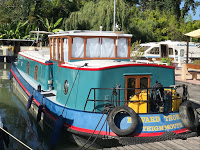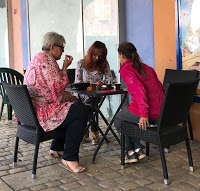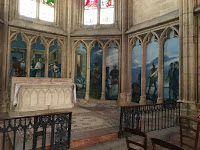In which Sid and Doris start out along the Garonne canals before striking out up hill, down dale, but mostly across country to the Gironde.
We are at peak French holiday season and today is the Friday between a Bank Holiday and the weekend so hotels are as much a limiting factor as our legs. Bazas is broadly in the right direction, has a Logis hotel and gives us another holiday ride.
When we take our home ride from Bishop’s Stortford to Saffron Walden and back (obviously by a different route) we do not have to eat all the food in the house before setting off. Now we are doing lower distances in temperate weather we are generously leaving food in the breakfast buffet for other hotel guests.

The picture shows the courtyard of the Prince Noir hotel. Le Prince Noir is not a reference to the artist known for Pretty Little Red Corvette. This is the eldest son of Edward III who seems to have been named after his black armour worn as one of the English commanders in the 100 years war, Crecy and the like, marauding through France just like Sid and Doris. Whose armour is much more brightly coloured so as not to be run over. What was the Prince thinking of, was there no health and safety rep with the expedition?

We are quite soon back along the canal, mostly flat with occasional vairy steep rises to get up to bridges over the canal such as this at Montesquieu. Again we have Sid’s favourite French bridges. There must be a name for this ubiquitous pattern.

Today we have an easy winner for vehicle of the day. It is a racing combine harvester from Team La Plume. Note the small spoiler, roll cage and the all round Armco armour. It may be a contact sport and we are sorry not to see it in action. Do they have these at the Festival of Speed or Monterey? And if not, why not? The public need to know.
 We occasionally see a maison a restaurer. Here along the canal a bateau a restaurer which has sunk, been refloated and left again. As with so many of the abandoned houses it has no future. Sid and Doris are [almost – D.] over the idea of buying the dream home in charming village. Like boats, you can hire them. I refer you to Bernie Ecclestone’s wise advice.
We occasionally see a maison a restaurer. Here along the canal a bateau a restaurer which has sunk, been refloated and left again. As with so many of the abandoned houses it has no future. Sid and Doris are [almost – D.] over the idea of buying the dream home in charming village. Like boats, you can hire them. I refer you to Bernie Ecclestone’s wise advice.

Just before leaving the canal we see this very smart boat from Teignmouth in Devon – there is another Epic Story there for someone. For all those who have not read Narrow Dog to Carcasonne: it is most charming and tells the tale of Terry, Monica, their dog and narrow-boat’s journey from Stone to Carcassonne.


Once out into the countryside we stop in Damazan village square at the women’s cafe. It seems you only need three for a proper coven, though more may be better. A sign on the square tells us that a decision has been taken to paint the houses in different colours, as it would have been in mediaeval times.


Lunch stop in Casteljaloux is a typical French town. Maybe more than typical because you really can have a Repas Escargolade. And Sid’s lunch is a beautiful croissant, filled with layers of ham and bechamel sauce with a grilled cheese topping. [We resisted taking a picture #nopicsoffood until it was almost too late… – D.]


As the afternoon goes by we think of another stop. To add to the recent picture of a marche couvert here is Grignols’ version, now taken over by Spar – which is better than demolition. We did try to order from the cafe, but the cafe dude vanished and in the end we had had enough rest and wandered off, but not before we had admired the charming faux branche balcony.
After about 70 k we climb steeply up into Bazas. This elegant small town is on the pilgrim route from Lourdes to Compostella, signaled by Coquilles, the sign of Saint Jacques.
 We observe that Bazas fails in its historic verisimilitude by having houses and shutters all of the same colour. In fact they seem to have mandated that only grey and silver cars can park in the own square too, in order to keep things uniform. (A sharp-eyed reader will spot the one dark red car on the far side of the square – permitted in order to balance up the single dark red sun umbrella.)
We observe that Bazas fails in its historic verisimilitude by having houses and shutters all of the same colour. In fact they seem to have mandated that only grey and silver cars can park in the own square too, in order to keep things uniform. (A sharp-eyed reader will spot the one dark red car on the far side of the square – permitted in order to balance up the single dark red sun umbrella.)
On the site of the cathedral there have been buildings since the third century AD. There was a substantial cathedral here in the mid 16th century. It was destroyed during the Wars of Religion. The wars between the Protestants and Catholics 1562 to 1598 are estimated to have cost three million lives in France alone from fighting, famine and disease. In WW1 France lost about 1.5 million and every town has a memorial, no such recognition from civil wars, as we know from Serbia, Greece and Spain. (We encountered the Thirty Years’ war earlier in the trip: eight million lives.) The Edict of Nantes (we may go through Nantes) gave the Huguenot Protestants the right to their own beliefs and practices. It probably all made a great deal of sense to someone at the time, though seems rough on the collateral damage.

The rebuilt cathedral has a Last Supper window featuring eleven nauseatingly saintly looking disciples and a splendidly villanous Judas Iscariot, as well as some truly excellent [although badly photographed, apologies – D.] paintings of the disciples fishing in the Sea of Galilee, which bring back memories of earlier stages in the Epic Journey.
Sid and Doris celebrated the Edict in the town square by eating some artisanal ice cream before moving on to the Hotel Domaine de Fompeyre. There was a brief fight over available dining times but both disease and famine seem to have been averted.

